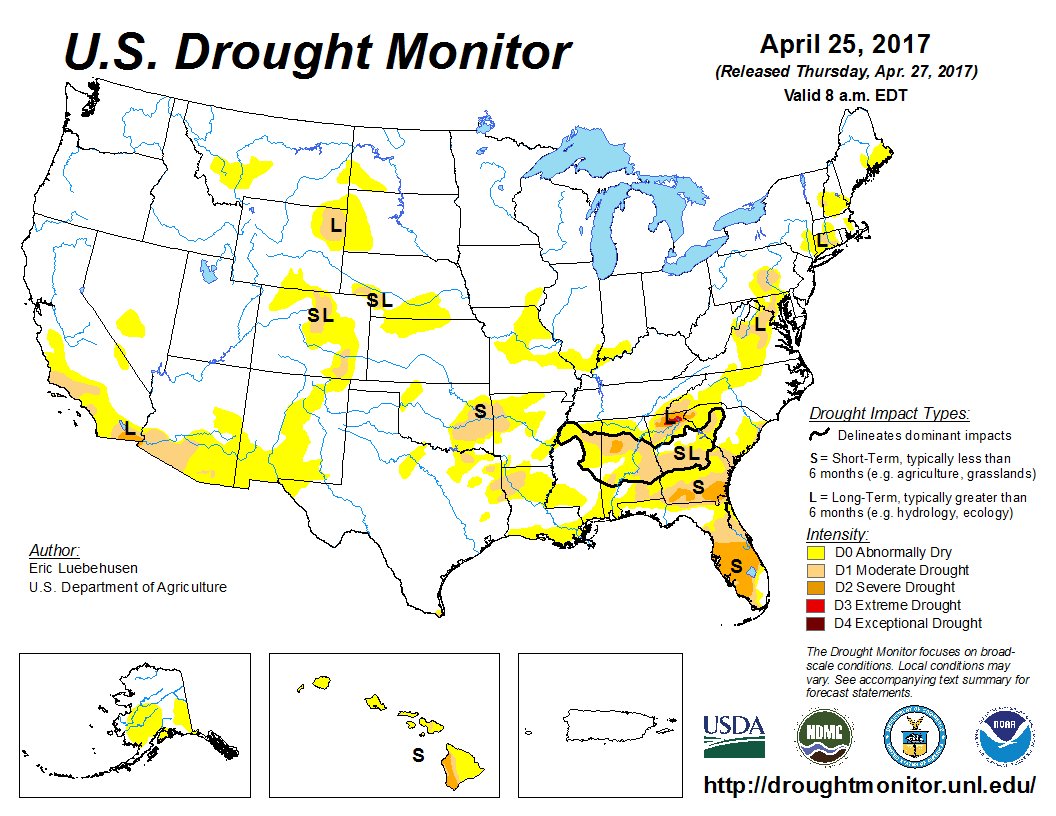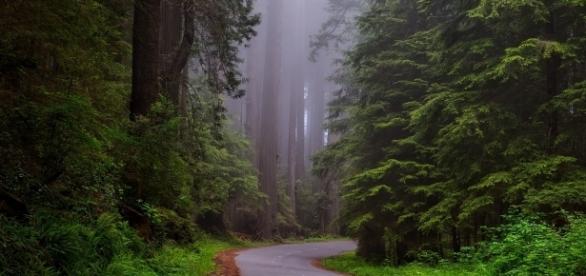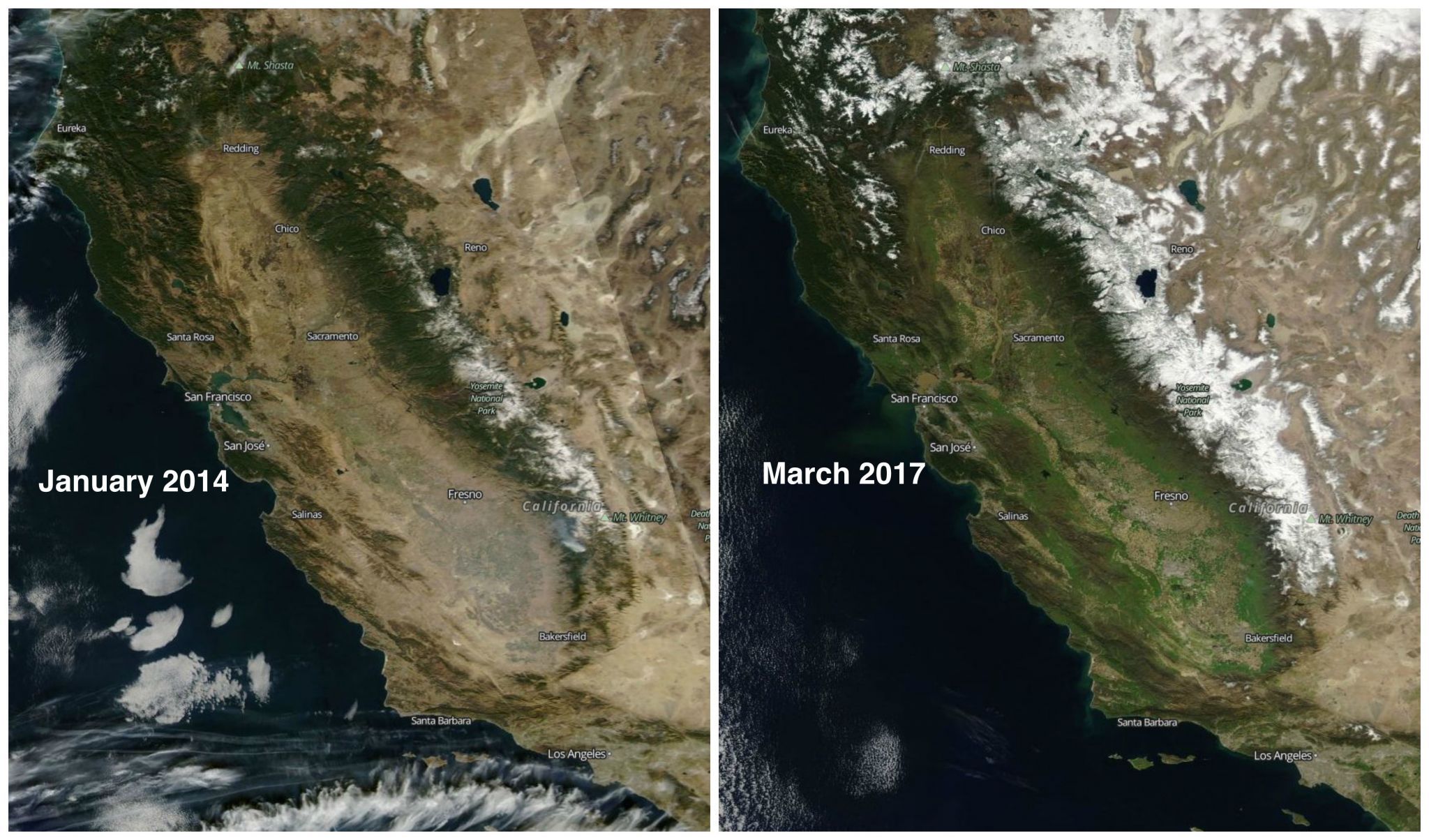Analysis: It’s not just droughts, but nearly all extreme weather is declining or at or near record lows
Climate Depot Special Report
The federal government has just released yet another key piece of scientific data that counters the man-made global warming narrative. The federal U.S. Drought Monitor report shows that droughts in the U.S. are at record lows in 2017. See: Feds: U.S. drought reaches record low in 2017 as rain reigns – Sees lowest levels of drought ever monitored
“Drought in the U.S. fell to a record low this week, with just 6.1% of the lower 48 states currently experiencing such dry conditions, federal officials announced Thursday. That’s the lowest percentage in the 17-year history of the weekly U.S. Drought Monitor report,” USA Today reported on April 27. (Ironically, climate activists had declared California to be in a permanent drought: Flashback 2016: Warmist wrong claim: ‘Thanks El Niño, But California’s Drought Is Probably Forever’)

Former Vice President Al Gore has made extreme weather warnings a staple of his climate change activist. See: Al Gore on the Weather: ‘Every night on the news now, practically, is like a nature hike through the book of Revelations’
Below is a complete rundown of the very latest on extreme weather conditions: Update data from the 2016 Climate Depot report: Skeptics Deliver Consensus Busting ‘State of the Climate Report’ to UN Summit
…Extreme Weather: Scientist to Congress in 2017: ‘No evidence’ that hurricanes, floods, droughts, tornadoes are increasing – Dr. Roger Pielke Jr. of University of Colorado
Hurricanes: 1) Inconvenient NOAA report: ‘It is premature to conclude (AGW has) already had a detectable impact on’ hurricanes & 2) NOAA: U.S. Completes Record 11 Straight Years Without Major (Cat 3+) Hurricane Strike & 3) 30 peer-reviewed scientific papers reveal the lack of connection between hurricanes & ‘global warming’
Floods: ‘Floods are not increasing’: Dr. Roger Pielke Jr. slams ‘global warming’ link to floods & extreme weather – How does media ‘get away with this?’ – Pielke Jr. on how extreme weather is NOT getting worse: ‘Flood
What “permanent drought”? New all-time rainfall record set for California
From the California Dept. of Water Resources Northern Sierra Precipitation Sets Water Year Record Atmospheric Rivers Pushed Total to 89.7 Inches since October 1 SACRAMENTO – Never in nearly a century of Department of Water Resources (DWR) recordkeeping has so much precipitation fallen in the northern Sierra in a water year.
Source: What “permanent drought”? New all-time rainfall record set for California…
Media false claim: ‘The weather has been weird’ – ‘There Was Nothing Normal About America’s Freakish Winter Weather’
Bloomberg News is promoting anecdotal claptrap. Excerpt:
By Brian K. Sullivan – Bloomberg News
It’s not your imagination. The weather has been weird.
So weird, in fact, it’s had an almost biblical feel: a February tornado in Massachusetts; record wildfires across the Great Plains and beyond; more snow than ever in the Sierra Nevada; and temperatures whiplashing from balmy to frigid, killing crops and coaxing flowers out of their winter slumber.
While some of the swings may result from chance, scientists agree climate change is adding to weather mayhem and that the world will have to brace for worse. President Donald Trump is also seeking to roll back measures to fight global warming, saying the regulations kill jobs.
“The bottom line: It’s not just in our minds that the weather is changing,” said David Titley, a meteorology professor at Pennsylvania State University. “It is changing, and changing rapidly in ways we understand and ways we are just beginning to examine.”
Start with the temperature. The winter of 2016-17 marked the second mildest on record, according to Jake Crouch, a climate scientist with the National Centers for Environmental Information. February, which has been warming faster than any other month through the decades, also was the second warmest in the 138-year global record. There were some bizarre temperature readings along the way. Like a high of 70 degrees Fahrenheit (21 Celsius) in Chicago on Feb. 18. Or 72 degrees in Boston less than a week later.
The month was so mild that natural gas inventories rose earlier than in any year going back to 1994, when records began, and plants threw off winter’s yoke and began to grow.
More nonsense here: https://www.bloomberg.com/news/features/2017-04-10/there-was-nothing-normal-about-america-s-freakish-winter-weather?bcomANews=true
#
Climate Depot Rebuttal:
Bloomberg media is claiming: “It’s not your imagination. The weather has been weird.”
Actually, it is your imagination, the weather is normal. A few basic rebuttals below.
Scientist to Congress: ‘No evidence’ that hurricanes, floods, droughts, tornadoes are increasing
False ‘Permanent Drought’ Alarm: California’s Rainy Season Now Ranks 2nd All Time In 122 Years Of Records
False ‘Permanent Drought’ Alarm: California’s Rainy Season Now Ranks 2nd All Time In 122 Years Of Records
California’s current rainy season can no longer lay claim to being No. 1. After relatively modest rainfall in March, this season now ranks as the second wettest in 122 years of record-keeping, according to data released Thursday by federal scientists. Between October 2016 and March 2017, California averaged 30.75 inches of precipitation, the second-highest average since such records began being kept in 1895, according to the National Centers for Environmental Information, part of the National Oceanic and Atmospheric Administration. Full post
— gReader Pro…
California’s governor says ‘never-ending drought’ is officially over
California’s governor says ‘never-ending drought’ is officially over
Gov. Jerry Brown once said the state’s drought was the new normal and blamed it on climate change—now it’s officially over
ADVERTISEMENTS
#California’s Gov. #Jerry Brown announced the ‘never-ending drought’ was officially over, despite previous comments that global warming was making it the ‘new normal.’ Numerous studies showed the state’s drought was normal, not historic, and unrelated to #Climate Change; previous dry spells in the Golden State have lasted more than 1,000 years.
A combination of factors drove California’s water shortage: an enormous Pacific blob of warm air off the Northwest coast and a high-pressure system stuck off the West Coast that was interrupting the normal cycle of yearly rains and snow. During the winter, meter-high snow packs would normally blanket the Sierra Mountains, melting in the spring and filling reservoirs below.
Another major issue: the state was still using the 1960’s open-air aqueduct system and leaky pipelines to transport water from rainier areas to drier areas, losing millions of gallons in the process. The aging infrastructure was created under Gov. Pat Brown (the current governor’s father) back in the 1960s. One-half of the state’s population lives in regions containing one percent of the natural supply of water, while the other half doesn’t.
Follow
In California, all eyes on dam’s eroding spillway as storms loom usat.ly/2kE3APr
More storms coming
Instead of using taxpayer dollars to upgrade the neglected system of dams, reservoirs, aqueducts, and pipelines, thus preventing a future catastrophe related to the uneven distribution of rainfall in the state, Brown spent billions on his bullet train to nowhere. Millions of gallons of freshwater currently flow into the Pacific Ocean, with even more lost to evaporation under the beating sun.
The governor’s announcement came as more springtime storms were on track to hit the already waterlogged state, taxing reservoirs, rivers, and dams. Four counties with low groundwater levels were still under emergency orders, though they were expected to be lifted soon. The drought has hurt native fish that migrated up once-dry rivers, forced farmers to rely more heavily on groundwater, and killed millions of trees.
…
Follow
@NASA satellites captured images of northern California
If Skeptics used same tactics as warmists: ‘It’s Official, Global Warming & Higher CO2 Ended California Drought!’
If the climate realists used the same tactics as the climate alarmists today’s headlines across the globe would read “It’s Official, Global Warming and Higher CO2 Ended the California Drought!!!” The entire climate change house of cards is largely based upon pseudo-science, where an outlier observation is portrayed as the norm. For example, the bleaching of the coral reefs is due to exposure to the sun, not more CO2. The loss of Arctic sea Ice is largely due to natural changes in the ocean and wind currents. Recent claims of a warming Antarctica are based upon an extreme case of cherry picking. Global temperature records are greatly influenced by known non-CO2 related factors such as the Urban Heat Island Effect, that when adjusted for, eliminate most of if not all warming from the data set. Experiments to demonstrate CO2 caused warming are simply laughable, as are the IPCC models created to “prove” the highly flawed theory. The number of hurricanes has collapsed, but you won’t find that in the headlines.
None of that matters however because climate “science” isn’t about science, it is about politics. It is all about how the story is spun. In reality, the “Social Cost of Carbon” is negative. There are astronomical benefits to burning fossil fuels and higher CO2 levels. Life expectancy, quality of life and economic growth have all increased along with atmospheric CO2. As has the “greening of the Northern Hemisphere.” Higher crop yields and lower food and energy prices are all directly associated with petroleum production and higher CO2 levels. Societies thrive during warm periods, they collapse during cooling and Ice Ages. Now, with the ending of the devastating California drought, by sticking with the standards and methods consistent with the field of climate “science,” we can now claim that global warming and the burning of fossil fuels has ended the California drought. The CO2 evidence is overwhelming. Higher CO2 “caused” the end to the California drought. The numbers simply don’t lie
.…
Scientists link California droughts and floods to distinctive atmospheric waves
From NCAR/UCAR: BOULDER, Colo. — The crippling wintertime droughts that struck California from 2013 to 2015, as well as this year’s unusually wet California winter, appear to be associated with the same phenomenon: a distinctive wave pattern that emerges in the upper atmosphere and circles the globe.
Source: Scientists link California droughts and floods to distinctive atmospheric waves…
Wildflowers bloom big across California’s desert
Rain-fed wildflowers have been sprouting from California’s desert sands after lying dormant for years — producing a spectacular display that has drawn record crowds and traffic jams to tiny towns like Borrego Springs.
An estimated 150,000 people in the past month have converged on this town of about 3,500, roughly 85 miles northeast of San Diego, for the so-called super bloom.
Wildflowers are springing up in different landscapes across the state and the western United States thanks to a wet winter. In the Antelope Valley, an arid plateau northeast of Los Angeles, blazing orange poppies are lighting up the ground.
But a “super bloom” is a term for when a mass amount of desert plants bloom at one time. In California, that happens about once in a decade in a given area. It has been occurring less frequently with the drought. Last year, the right amount of rainfall and warm temperatures produced carpets of flowers in Death Valley.
So far this year, the natural show has been concentrated in the 640,000-acre (1,000-square-mile) Anza Borrego State Park that abuts Borrego Springs.
Scientist to Congress: ‘No evidence’ that hurricanes, floods, droughts, tornadoes are increasing
Testifying before Congress, environmental studies expert Dr. Roger Pielke Jr. says the UN IPCC’s own data shows there’s “no evidence to suggest” that hurricanes, floods, droughts, or tornadoes are increasing.
DR. ROGER PIELKE JR: “In the United States the number of hurricanes and the intensity of hurricanes is down by 20 percent since 1900. I don’t put a lot of stock in that because you can start at different dates and get different trends but the point is that there is no evidence to suggest that hurricanes, either in the U.S. or globally, are increasing and the same goes for floods, drought, and tornado. And, don’t believe me. You can look at the appendix that I provided with data from the IPCC. So why people would hang their hat on long term trends in extreme weather is a puzzle.”
Hearing – Climate Science: Assumptions, Policy Implications, and the Scientific Method
US House Committee on Science, Space and Technology
March 29, 2017
From Pielke Jr.’s Written Testimony:
“There is little scientific basis in support of claims that extreme weather events – specifically, hurricanes, floods, drought, tornadoes – and their economic damage have increased in recent decades due to the emission of greenhouse gases. In fact, since 2013 the world and the United States have had a remarkable stretch of good fortune with respect to extreme weather, as compared to the past.
The lack of evidence to support claims of increasing frequency or intensity of hurricanes, floods, drought or tornadoes on climate timescales is also supported by the most recent assessments of the IPCC and the broader peer reviewed literature on which the IPCC is based.
I have included an update of relevant data and summary conclusions of the IPCC related to trends in extreme weather as an Appendix B to this testimony.…
California has a brief break before getting pounded again – Clock is ticking on a dam crisis
Computer forecast models indicate a powerful jet stream will continuously pound California over the next ten days and bring copious amounts of moisture from off of the Pacific Ocean into the state. This 10-day loop of predicted upper-level winds at 250 mb are in 6-hour increments from today until Thursday, February 23rd; maps courtesy tropicaltidbits.com, NOAA/EMC (GFS)
Overview
There have been many occasions in the past in which floods have followed droughts in California and this recent time period is yet another example. In California, incredible amounts of rain have piled up in recent weeks across low-lying areas of the state, mountains of snow have accumulated in the higher elevations of the Sierra Nevada Mountains – and more is on the way. After a couple days with a break in the action, another storm is likely to arrive in northern California by later Wednesday and continue into Thursday and then a second storm looks like it will slam the entire state by early this weekend.
The next storm arrives in northern California later Wednesday and lasts into Thursday; map courtesy tropicatidbits.com, NOAA/EMC
California blitz to continue
After a lengthy drought, California has been battered by potentially record-setting rain, with the Northern California region getting 228 per cent more than its normal rainfall for this time of year. The average annual rainfall of about 50 inches had already been overtaken with 68 inches in 2017 alone and another 6+ inches is possible over the next week-to-ten days. The latest computer model forecast of upper-level winds for the next ten days (Monday, 2/13 to Thursday, 2/23) does not hold out much hope for any significant drying in California. Powerful winds in the upper atmosphere (at 250 mb) will continuously pound California and bring copious amounts of moisture from the Pacific Ocean into the state. The total precipitation forecast map by NOAA for the next 7 days indicates more significant rainfall (and snowfall) is likely throughout the state.
A second storm is likely to arrive in California by the upcoming weekend and this system is likely to impact the entire state; map courtesy tropicatidbits.com, NOAA/EMC
The first storm looks like it will arrive later Wednesday and continue into Thursday and be concentrated in the northern part of the state. Just a few days later, a second storm will push in from the Pacific Ocean, and this storm looks like it’ll …









